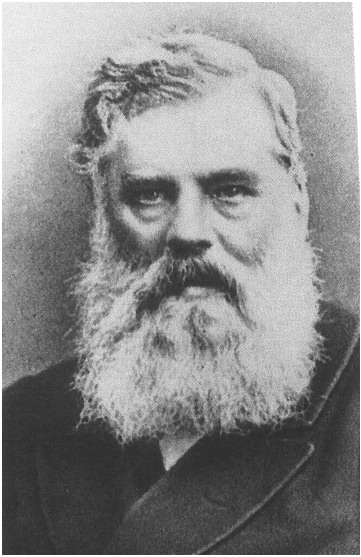
Relatives of R.D. Oldham
Charles Frederick Oldham (uncle,) wrote several books and articles with Indian themes: 1871 What is malaria? : And why is it most intense in hot climates? An enquiry into the nature and cause of the so-called marsh poison, with remarks on the principles to be observed for the preservation of health in tropical climates and malarious districts. London : Lewis, 1871. xvii, 186 p ; (8vo). 1874 Notes on the lost river of the Indian desert by C.F. Oldham. Calcutta: City Press, 1874. 27p.; map; 22cm. 1905 The sun and the serpent : a contribution to the history of serpent-worship by C.F. Oldham. London : Archibald Constable, 1905. 207p, [33] leaves of plates ; 23cm. and in 1893 The Saraswati and the lost river of the Indian Desert. J. Roy. Asiatic Soc (1893) 49-176.
Charles Aemilius Oldham 1831-1868 Youngest son of Thomas Oldham (senior) and brother of Richard's father (Dr. Thomas Oldham - junior) was a geologist in southern India who married Evelyn King, the second sister of William King (who directed the Geol Survey of India after Medlicott's term). He died age 38 inWellington Road, Dublin from painful complications arising from Guinea worm poisoning contracted near Madras. He was survived by a young wife and a son ( Obituary in Geol Mag 1869, VI. p 240. ) See Wyse Jackson, Patrick N., The Geological Curator,Trinity College Dublin, Professionals in India: the lives and friendship of Charles Æmilius Oldham (1831-1869), geologist, and Thomas Hardinge Going (1827-1875), railway engineer, Abstracts of the 28th INHIGEO international symposium on Geological travellers, Trinity College, Dublin (2003),58

Thomas Oldham (Richard's father, above)
Dr. Thomas Oldham was born in Dublin in May 1816 and entered Trinity College Dublin before the age of 16. After his BA between 1837 and 1838 he studied engineering and geology and mineralogy under Jamieson. In 1839 he was appointed Geological Assistant to Captain Portlock RE mapping the geology of Derry and Tyrone counties in Ireland. In 1844 he was appointed assistant professor in Engineering at Trinity College Dublin. In 1845 he was appointed to Chair the Geology Department and in 1846 until 14 Nov 1850 Director of the Geological Survey of Ireland. In late 1850 he married Louisa Matilda Dixon, eight years his junior, and sailed almost immediately for India arrived in Calcutta in 1851 and for the next 25 years was the Director of the Geological Survey of India.Two Cambrian trace-fossils were named after T. Oldham (Oldhamia antiqua & radiata ) who discovered them while a youth in Ireland. The monosulphide mineral of Calcium Oldhamite was named after him in 1862 following analysis of a meteorite (the Busti aerolite) that fell 2 Dec 1852 near Goruckpur shortly after his arrival in India. This isometric sulphide of (CaMg)S is a frequent component of enstatite meteorites. He died 17 July 1878 in Rugby (see obituary and gravestone below)
Events leading to Prof. Thomas Oldham's Appointment in India: Henry Thomas De la Beche, the director of the Geological Survey of Great Britain, was consulted about the appointment of a geological advisor to the East India Company to help India become independent of imported coal. In June 1845 he recommended David Hiram Williams who had worked successfully on the coals of Wales and the Forest of Dean. The East India Company wrote to Williams and offered him an appointment for 5 years at £800/year, with a £200 passage allowance there and back. On 8 June 1845 Williams wrote to De la Beche indicating he would accept the appontment in India "My wife will regret the separation, but she is too good to object to the idea as it will do much for our little ones". By1846 he had confirmed a 200 foot thickness of coal in the Damoodah coal field " more fuel than any coal field in Great Britain or America". His search for new coal seams, and his mapping of the Damoodah field continued in the next two years with an assistant ("someone in the best of health") appointed with a salary of £500/year. He survived an outbreak of cholera in Calcutta, and sent money home to his wife, but on 1 June 1846 learned of the death of his youngest daughter. On 22 December 1847, presumably concerned with his own health, he made a will and wrote to De la Beche appointing him as an executor. Less than a year later, on15 November 1848 while prospecting, he fell from his elephant and died subsequently from jungle fever (malaria), leaving W. Theobald, Colonel Forbes and De la Beche as trustees and executors (letter from Theobald to Mrs Williams forwarded to De la Beche 7 Dec 1848)
Two lengthy reports were published posthumously by the East India Company under his name [ D. H. Williams, Geological Surveyor tof the East India Company]. They are bound in a single volume in the GSI HQ in Calcutta.
Williams, D. H. (1850) Geological Report on the Damoodah Valley,, London, 1850. pp. 131
Williams, D. H. (18520) Geological Report on the Kymore Mountains, Ramghur Coal Fields and the Manufactire of Iron etc etc Calcutta 1852 pp 92
On 14 March 1849 De la Beche wrote to the East India Company requesting a pension for his widow indicating that Williams had died during his search for coal in India. Presumably the company were complacent because of the rich coal reserves available in Damoodah, for it took a year for the Company to request that De La Beche suggest a successor to replace Williams. In early March 1850. De la Beche recommended Thomas Oldham. On 7 March Oldham initally replied to De la Beche from the Geological Survey office, Dublin, with a weak declination: "Regarding the opening in India, I am grateful for the offer. The appointment is not one that I would like to decline without consideration, but I am disposed to say no. I would much like to go, but I have many dear ties here. I derive no great emulument from my Survey appointment. I will give you a definite answer at once, when any further information on the arrangement is available".
It is probable that the East India company offered Oldham the same 5 year term appointment as Williams (at £800/yr), for on 12 March Oldham wrote again to De la Beche, this time from 18 Pembroke Road, Dublin, "After a good deal of thought I have decided to refuse the offer of the India appointment under the terms stated. But if they give me £1000, and two assistants of my own choice, and travelling cost etc. I will accept." On 15 May, this time from Folkes Mill, New Ross, he wrote " Has anything been done about the India matter? There is an unpleasantness about suspense. Besides, I wish to invest in a horse if I do not go, since it will save money, given the absurd regulation of the Survey, of travel within 15 miles of station." and on 24 May from Wexford " Regarding India, I asked the board to secure an assistants pay, not to provide passage and outfit. A £1200 salaray would allow me £200 to implement my views. " This was apparently accepted by the East India Company (but not without some resistance for William Henry Sykes wrote to De la Beche "You should write a semi-official letter to Captain Shepherd explaining why a geologist cannot be found for India, under £1000. I f you propose Oldham at that sum , you might get a favorable answer sub rosa, and then you can write officially") . The East India Company must have agreed to the sum and it may have given Oldham the security about future income needed to consider marriage. On 25 Sept he wrote from Clonmel "The East India Company have consented to my not going to India until December. I will lecture at college until the coming term. On 18th Oct he married Louisa Dixon. On 18 November he wrote from The Survey Office " I am preparing to go eastward, and shall be soon beyond the fogs and damps of this climate." followed by a letter of resignation from the Irish Geological Survey that required a note of clarification on the 20th "I am sorry you thought there was personal hostility in my letter of resignation. I have expressed the same opinions frequently to you, and you have not taken them so. I could not leave the Survey without setting the facts on record, in the hope that Lord Seymour will make the arrangement workable by modufying them." His last surviving note to De la Beche before departure (undated) expresses" Best thanks for all your trouble about India. I shall write again concerning it."
Thomas Oldham and Louisa Matilda Dixon were married 18th Oct 1850 (letter from A. C Ramsay to De la Beche 19 Sept 1850) and set off for India as planned in December 1850. Louisa Dixon's father was William Dixon of Liverpool. Thomas Oldham's father was also named Thomas Oldham, and his mother was Margaret Bagot (of the Bagots of Kilcoursey.)
Thomas Oldham's interest in earthquakes developed while gathering materials on the 1869 Cachar earthquake. Soon after the death of Charles Aemelius Oldham in Madras (his brother or cousin?) he started compiling information on other Indian earthquakes (see his request for earthquake information in 1870. In 1882 Richard Oldham turned these notes into published articles. A list of T. Oldham's articles is found in Richard Oldham's Bibliography, in the Geol Mag. obituary (1878 p.373), and also in Pascoe's multivolume bibliography of Indian Geology published in 1957.
Oldham retired in 1876 on a pension of £600/year that was increased to £700/yr in 1877. To have qualified for a full pension he would have to have worked for 30 years not 22. Valentine Ball retired with a pension of only £142/year (200 Rp) based on 17 years work. Thomas Oldham's net worth at the time of his death in 1878 was less than £2000.The 1871 Census Details about the family from the 1871 Rugby Census (Thomas Oldham the father was probably in India at this time. Sarah and Lizzie Barnacle were cook and housemade at the house on Hillmorton Road (1 Eldon Place) Rugby. Eldon Place is inscribed in stone below the centre top window of 30 Hillmorton Road (above) now the Diamond House Hotel (identified by Christine Hancock and Chris Hicks of the Rugby Local History Research Group). The house backs onto one of the Rugby School playing fields and faces the playing field of Lawrence Sheriff School. Rugby school lies a half mile west along Hillmorton road. It would have been an ideal location for a family of school-age children and it is probable from the size of the family and the two maids, that the Oldham's occupied the whole house.
Louisa Matilda Oldham 1824-1900 , Richard Oldham's motherwas born in 1824 in Seacomb, Cheshire. In the 1881 census she records her age as 56,and having been born in CHS Liscard. She lived in Shrewsbury 1891 and was visited by Tom LaTouche 20 June 1996 when she would have been 72. La Touche describes her as a dear old lady, and gives us a rare glimpse of Richard Oldham - "Mr Oldham's conceit must be original sin I think, he could not have got it from his mother at any rate." On Thomas Oldham's tombstone in the Clifton Road Cemetery Rugby her birthday may be calculated as 1824
6 May 1891, Calcutta, Mss Eur C258/10 Tom LaTouche to Nancy LaTouche
I met one of my colleagues , Mr Oldham, on my way down from Daltonganj. He has just come in from Baluchistan where he has been looking for oil. He tells me his mother Is living in Shrewsbury, where his sister is one of the nurses at the infirmary. I would be very glad if sister Grace would call on them some day when she goes for her music lesson. Their address is 'Windsor House'. It is somewhere near St Mary's.
Stokesey 20 June 1996 C258/62 to Nancy in Kingston, Ireland
We have all been to a concert at Shrewsbury in which Mary was one of the performers, Mary played her viola in three pieces and is very much pleased with herself. After it was over I went to call on Mr. Oldham's mother who is living at Shrewsbury. She seemed very glad to see me and is a dear old lady. Mr Oldham's conceit must be original sin I think, he could not have got it from his mother at any rate.
Louisa Oldham died 14 April 1900 at the age of 76. "In Loving Remembrance of Thomas Oldham who departed this life July 17th aged 62 years. And of his wife Louisa Matilda Oldham at rest 14th April 1900 aged 76 years. Not my will, but thine, be done Luke 22:42" " (ackn. to Christine Hancock, Rugby History Society for photos below). The memorial stone to Thomas and Louisa Oldham is a single block of granite with a prismatic shape quite unlike any of the other graves in the Clifton Road Cemetery. At the time of their mother's death Dorothea was a nurse in Falmouth and Richard was on furlough researching seismograms in England, some of the time staying with his sister. It is possible that the granite gravestone replaced an earlier locally typical marker for Thomas. The children: Dorothea, Hugh, Edward, Richard and Henry Oldham may have chosen this unusual 1900 granite slab as an appropriate memorial to Thomas Oldham's remarkable contribution to geology.
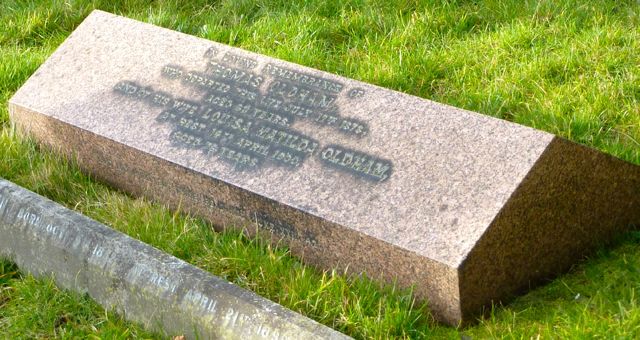
The granite is a single block with a base measuring 64"x24"x5.5" surmounted with a triangular prism rising to an apex 6.75" higher. The granite looks faairly generic with quartz, orthoclase and plagioclase and some hornblende.
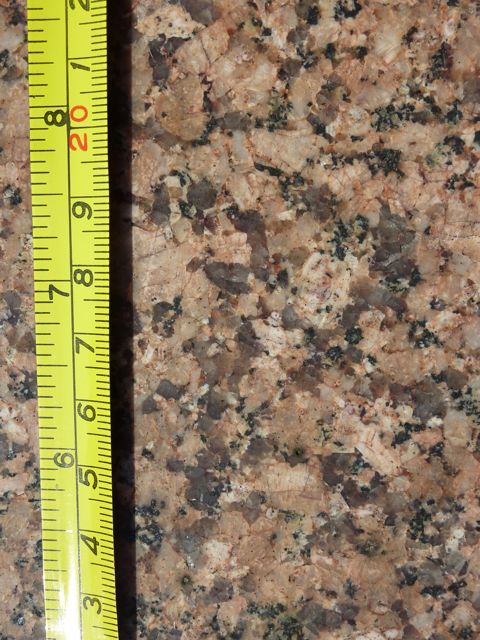
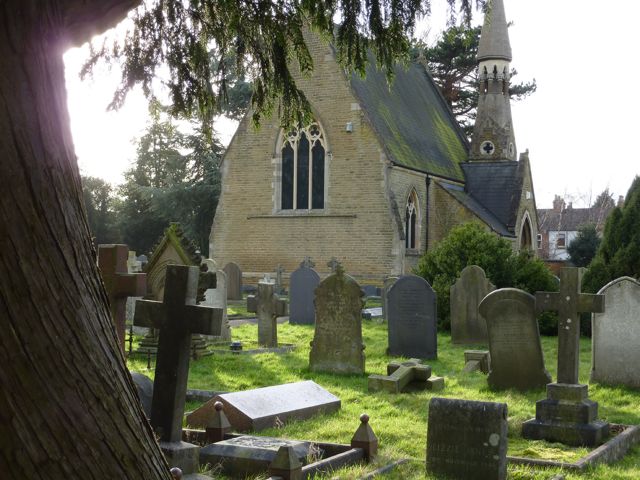
Thomas and Louisa Oldham had one daughter, Dorothea, followed by five sons, Hugh, Edward, Richard, Thomas and Henry. The boys were all named after friends of the family.
Dorothea Margaret Oldham 1851-1926 (Richard's elder sister was 19 in 1871) was born 16 October 1851in Cherra Punji , a village south of Shillong, the hill resort town on the 1.5 km high plateau north of Calcutta. She was christened 2 Nov 1951 in Agra 2 Nov 1851 apparently Dorothy not Dorothea but this may be a transcription error in the India Births and Baptisms page. In her father's 1854 account on the Geology, Meteorology and Ethnology of Meghalaya, Dr. Thomas Oldham remarks "Shortly after my arrival in this country, in the commencement of the year 1851, finding that it would be impossible at that season of the year to commence field operations in the plains of Bengal, I proceeded, with the sanction of the government of Bengal, to the station of Cherra Poonjee, with a view to examine the mode of occurrence, extent, and character of the iron ores, which had for many years been known to have been worked in these hills. I arrived at Cherra Poonjee in the middle of the month of June, and left again in the beginning of November.... during the five month's duration of my visit in that year, 1851, there fell at Cherra Poonjee nearly 400 inches of rain.....and having no Assistants I was unable to accomplish very much." Clearly Dorothea was born during this field trip. Dorothea apparently trained as a nurse and was reported working in the Shrewsbury infirmary living with her mother in a letter from Oldham in 1891, but it is possible that that was the year she became a matron in Devon, for she is described as a hospital matron in Falmouth in the census records of 1891 &1901. In 1917 she was living in Kew with her brother, Richard. She was a member of the Royal British Nurse's Association, and a founding council member of the Central Midwives Board 11 Dec 1902, and resigned in 5 Nov 1904. She was elected to the Council of the Midwives Institute 27 July 1907. She is reported (at age 64, Nature 18 Nov 1915, (2403) vol 96, p329) attending the British Association meeting on education where she argues eloquently for education for women. Some of her correspondence with Florence Nightingale is on file in the British Library. She died 1 Nov 1926. Richard Oldham stayed with her in Falmouth when on leave from India in 1900/1. Photo below is of Cherrapunji in 2004 (numerous spellings but now abbreviated to Cherra, population 5000 in 1900) claimed to be the wettest place on Earth. Richard Oldham visited it in 1897 when investigating the great Assam earthquake. Dozens of miners were buried in the Cherra Punji coal mine that collapsed in the earthquake. Dorothea died in London 1 Nov 1926 never having married, leaving £1063 5s 1d to her brother Richard (none to the other brothers apparently).
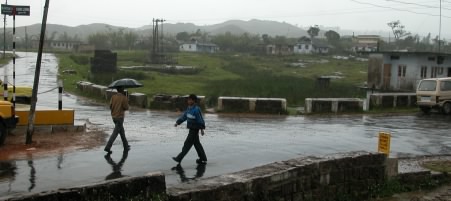
Hugh Falconer Oldham 1852-1930 (18 in 1871) was born 1852 in India. He is named after his father's geological colleague (the paleontologist and naturalist Hugh Falconer 1808-1865) Admitted Rugby 11 Jan 1868. Became MD Left Rugby 1871 Colton Cottage, Morecombe. He was awarded an MBE in 1920. He died in Morecambe in 4 Jan 1930.(Br. Med J. 1930 January 18; 1(3602): 131–132) His only son, Thomas Vicars Oldham was born 31 Jan 1889, also became an MD, and died 31 May 1957 at the age of 68 in Harrow (British Medical Journal 29 June 1957. See descendants entry below. As apparently the last surviving nephew of R.D. Oldham it was this Tom V. Oldham who inherited Henry Yule Oldham's estate in 1951. T.V. Oldham's two daughters may have inherited some of R.D. Oldham's materials. The following is from 298 Lancashire 1917 biographies and Rolls of Honour.
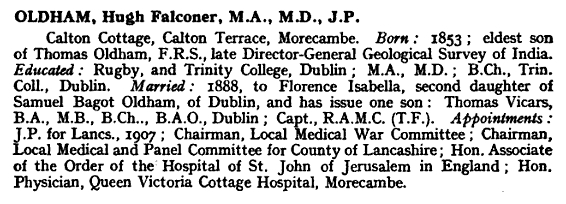
Edward Forbes Oldham 1854-19?? (16 in 1871) was born 21 August 1854 in Monghyr, India. [From page 313 rugby 2 Admitted aged 15 to Rugby 21 jun 1870. Left 1871 - Sometime a tea planter in India, Residing at Bletchley 1902.) Named after his father's palaentological colleague Professor Edward Forbes who died in 1854. Thomas Oldham (EF Oldhams' father) was the best man at Edward Forbes' wedding in 1848. E. F. Oldham Joined the Institute of Journalists in 1890, worked on the Dublin Evening Echo, and was on the staff in 1893 at the North Bucks Times (Fenny Stratford), staff from1896 to 1901, Address at 1901: Fenny Stratford, Bucks. I have been unable to trace him after 1902, however he edited the "Year Book and Directory" for Fenny Stratford, Bletchley, Winslow and Woburn Sands under the name E. Forbes Oldham (published Leighton Buzzard, 1908).
Richard Dixon Oldham 1858-1936 ( was 12 in 1871) and was born 31 July 1858 in Dublin Left Rugby school 1875. Emmanual College Scholar 1875, Associate School of Mines. Joined Goelogical Survey of India in 1879, retired in 1902. See chronological biography
Thomas Bagot Oldham 1861-1884 (9 in 1871) was born in India 18 August 1861 (christened 23 Oct 1861in Calcutta) but died at the early age of 23 in Assam (10July 1884). He second name is named for his grandmothers (his father' mother's) name of Bagot. Also note that his elder brother married into the Bagot family four years after Thomas BagotOldham died. At school in Rugby in 1878 and 1879 he wrote articles on the fossils in (Geology in the neighbourood of Rugby (Rugby Nat His Soc 39-46, 54-58, 1879) and won a couple of school prizes for these reports. In the Rugby Gazette of 1900 he is recorded as living at 18 Hillmorton Road, arriving at the school in 1874 (18th Aug aged 12), and leaving the school in 1880. The author Charles Sayle was a schoolboy friend of T. B. Oldham. Charles Sayle's 1887 historical play "Wiklif", is dedicated to Thomas Bagot Oldham in memory of their schooldays in Rugby. At the end of the drama Sayle writes a short poem that describes visiting a fossil quarry in Lutterworth near Rugby in 1879 when Thomas would have been 19.
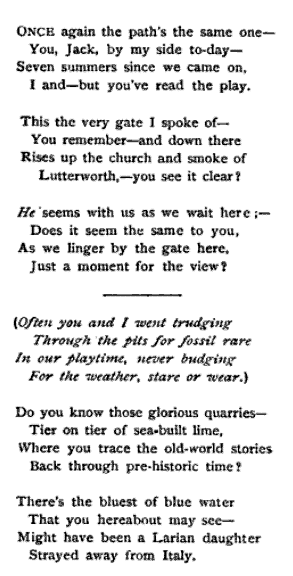
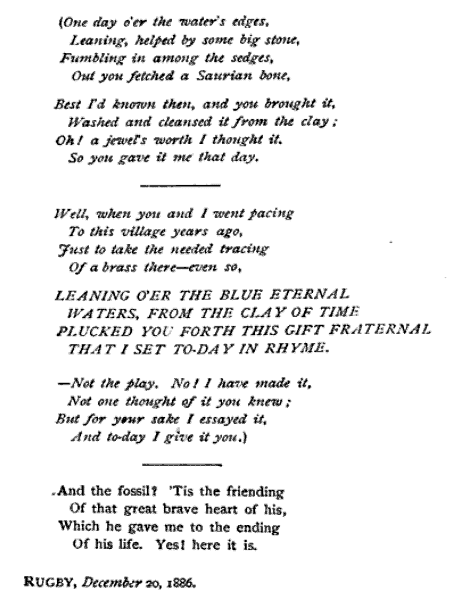
Henry Yule Oldham 1862- 1951 (8 in 1871) was born in Dusseldorf (then Prussia in 1862). [ Henry Oldham was named after his godfather, Sir Henry Yule, an engineer who described the iron ore of the Shillong plateau in 1842 and who, as Captain H. Yule, accompanied Richard's father, Thomas Oldham, to Burma in 1858. He wrote numerous biographies, a book on Marco Polo and Hobson Jobson, an etymology of Indian terms]. Henry Oldham graduated from Jesus College Oxford in 1886, visited paris University in 1888 as a tutor to the Duc D'Orleans, was RGS lecturer at Owens College Manchester 1892, and joined Kings College, Cambridge June 1893. Taught geography at Cambridge 1893-1898, was appointed to a Readership (1898-1908), and was the University Lecturer in Historical and Economic Geography 1908-1921. He wrote "A pre-columbian discovery of America, Geog. J. March 1895) and demonstated that the world is round on a straight 6-mile-canal with three equally spaced bridges. A telescope showed the central bridge to be six feet higher than the chord joining the two ends. He died in 1951 and left £2372 12s 11d to Thomas Vicars Oldham, a medical practitioner, the son of Hugh Falconer Oldham.
In Natural Science 1898, 12, 285 appears an announcement that the lectureship in Geography at Cambridge is now a readership for HY Oldham with a stipend of 200 pounds a year. He is listed on the Passenger List for RMS "Saxon" as travelling to Capetown 29 July 1905 and is recorded briefly at a 4 Nov 1915 meeting describing the exploration of Australia (Nature 2410(96) p275). (The following extract from D. R. Stoddart (A Hundred Years of Geography at Cambridge) in The Geographical Journal, Vol. 155, No. 1. (Mar., 1989), pp. 24-32 places these appointments in context: ."Oldham seems to have been a genial unexciting man, interested in the history of geographical discovery, but who published almost nothing. Nevertheless the RGS continued its financial support [for his position at Cambridge], and in 1898 the lectureship was upgraded to a readership and Oldham was elected.....[I omit information here on course changes etc ]....Perhaps Oldham was not up to these new demands, and gradually he lost the confidence of both the university and the RGS. In 1908 he was required to vacate his Readership, in spite of the support of Sir Clements Markham. Markham's successor at the RGS insisted on a re-organisation at Cambridge as the price of continued RGS support. Oldham took the title of RGS Lecturer in Economic Geography until he retired in 1921. Philip Lake was brought in as the RGS Lecturer in Regional and Physical Geography.... Then 43 years old , he had read Natural Sciences and served briefly with the Geological Survey of India. Lake was appointed to a Readership in 1918, was RGS Reader 1921-1926 but resigned in 1927. " Philip Lake wrote Richard Dixon Oldham's obituary in 1936 using the initials P.L. (Lake first met R.D. Oldham in the GSI in 1884 but he "was rapidly invalided home" after three years. His articles in India are erudite and insightful. Lake died in Cambridge 14 March 1951 having never married.
The 1881 Census Details about the family after Richard left for India comes from the 1881 Rugby Census (Emma Rowley and Fanny Mann were cook and housemade at the house on 2 Arnold Villas, Rugby. Four of the boys had by now left home (Hugh, Edward and Thomas disappear from the horizon of academic publications completely after this time); the mother Louisa Matilda (then 56, records her birthplace as CHS Liscard), daughter Dorothea (then 28), and youngest son Henry (then 23). A niece aged 23, Amy Sinela Gordon (born Simla) also lived in the house at this time. The photo below of 2 Arnold Villas was provided by Christine Hancock in Feb 2010.
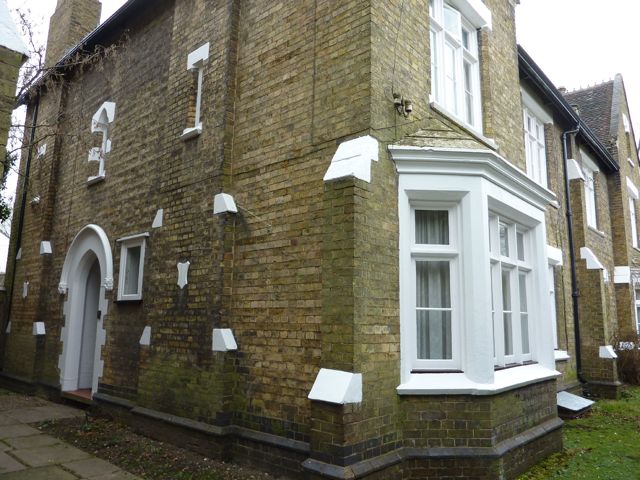
It appears that of Richard Oldham's entire generation, only Hugh Falconer, the eldest son, left any descendants. Hugh's son Thomas Vicars inherited the estate of Richard's brother Henry Yule, and was survived by two daughters but I have been unable to trace them. Richard Dixon's estate reverted to the crown suggesting that he had lost contact with his brother Henry Yule by 1936.
Thomas Vicars Oldham son of Richard's brother Hugh.F. Oldham, , was born 31 Jan 1889 and died at the age of 68 31 May 1957 in Harrow. His obituary is reproduced below (British Medical Journal 29 June 1957. T. VICARS OLDHAM, M.B., B.Ch. Dr. T. Vicars Oldham died at Harrow Hospital on May 31 at the age of 68. Thomas Vicars Oldham was born on January 31, 1889, the son of Dr. Hugh Falconer Oldham. From Rugby School he went on to King's College, Cambridge, but for most of his time as a medical student he lived in Dublin, graduating M.B., B.Ch. at Dublin University in 1914. Entering the R.A.M.C. on the outbreak of the first world war, he served mostly in the Middle East, having previously taken part in the Gallipoli landings. When the war ended he remained as a regular R.A.M.C. officer until he retired with the rank of major in 1928 to join his father in general practice at Morecambe. He was chairman of the Lancaster Division of the B.M.A. in 1929-30. In 1934 he came south to Harrow-on-the-Hill, where he took over the practice of the late Dr. W. A. Wilson-Smith. At the outbreak of the second world war in 1939, and within a month or two of completing his period as a reservist liable to recall, he was recalled to the R.A.M.C. and served throughout the war, first at Newport, then as liaison officer for South Wales, and finally in the medical supplies department at the War Office. On his return to Harrow after the war, in addition to reestablishing himself in general practice, he was responsible for the medical care of the boys of Malvern School, who shared the premises of Harrow School during the war, working in close contact with Dr. 0. R. Tisdall, the then medical officer to Harrow School. A colleague writes: Having thoroughly re-established himself in general practice, but looking forward to retirement in the near future, Tom Oldham was struck down with tragic suddenness while doing his evening surgery on May 31 and died from a coronary attack shortly afterwards in Harrow Hospital. Although he did not hold any of the more prominent offices in public life, he could always be found doing a lot of the drudgery and less spectacular jobs with cheerfulness and marked efficiency. He was for many years a member of the hospital staff at Harrow and a member of the hospital committee. He was interested in all forms of sport and at one time was a first-class golfer and a strong supporter of medical golfing societies, particularly that of Harrow and Wembley hospitals. It has been said of a man, rather as a compliment, that " he did not suffer fools gladly." It was rather the reverse with Tom Oldham, and therein lay his charm and his success in general practice. Only those of us who took on some of his work on the rare occasions on which he took a holiday knew to what extent he devoted himself to his patients, particularly the very young and the very old. It is not given to us all to show the patience and attention which he did to his patients and which went far beyond his " terms of service." He died, as he would have wished, quite suddenly, after a life blessed by good health. He will be sadly missed, not only by his widow and two daughters, but also by his many patients and his medical colleagues in Harrow.